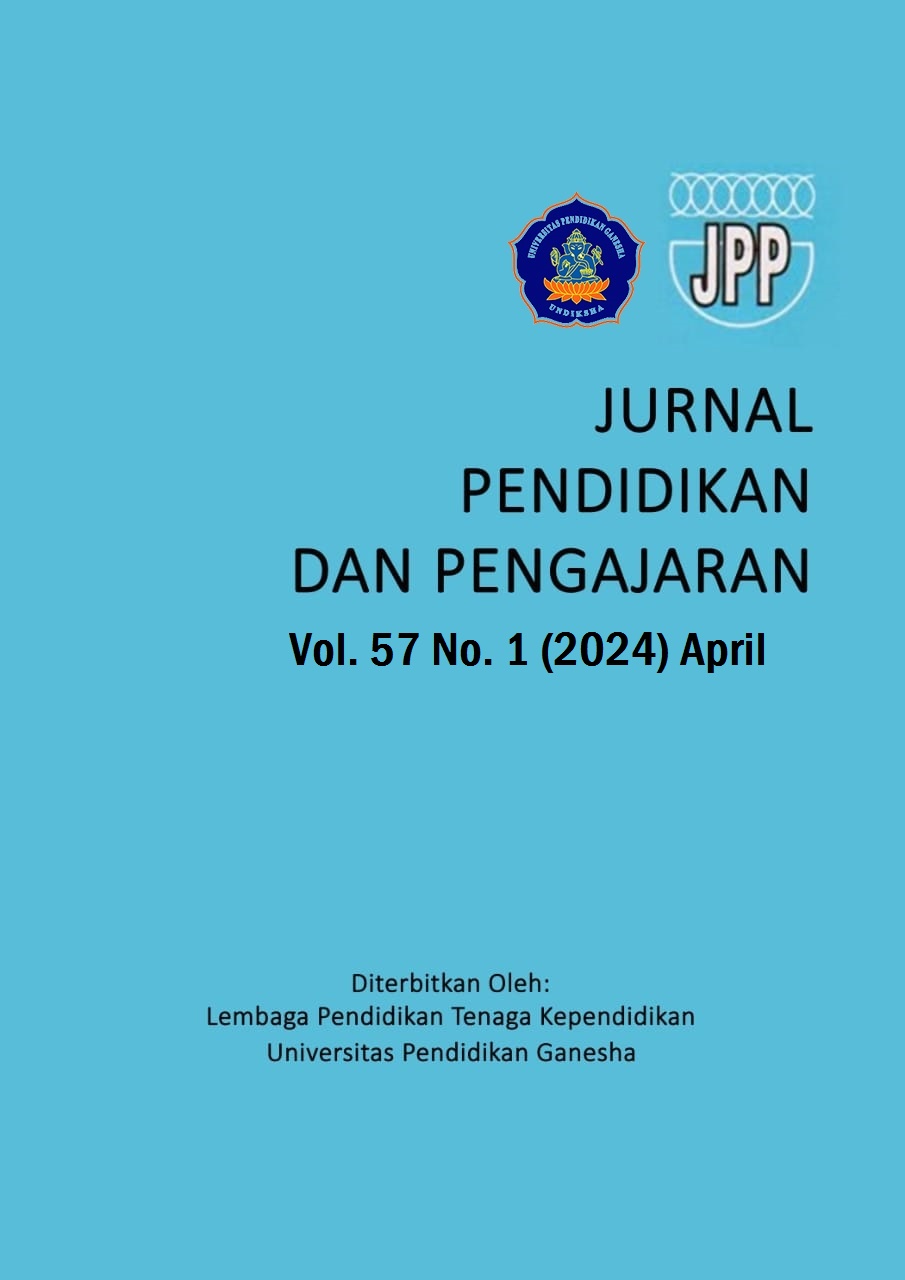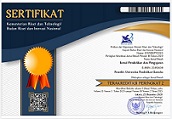Conceptions of Differentiated Instruction: A Case Study of Junior High School Mathematics Teachers
DOI:
https://doi.org/10.23887/jpp.v57i1.67949Keywords:
Merdeka Curriculum, Differentiatied Instruction, Mathematics LearningAbstract
Differentiated learning is a learning approach that adapts to the individual needs of students, both student readiness, interests, and their learning profile. Although this concept has been widely discussed, its implementation in mathematics learning still encounters many obstacles. This study aims to describe the conception of mathematics teachers towards differentiated learning and its implementation in supporting the Independent Curriculum. This research is qualitative research using questionnaires as a data collection method. The subjects of this study were 27 junior high school mathematics teachers in the city of Surakarta. Data is analyzed using qualitative analysis techniques including data reduction, data presentation, and verification/conclusions. The results showed that teachers' understanding of differentiated learning was good, both in theoretical concepts and implementation. However, teachers still face obstacles in design, limited learning time, classroom management, and limited knowledge on some aspects of differentiated learning. The study concluded that even though teachers already understand the concept of differentiated learning, they need further support to overcome existing barriers. The implications of this research point to the need for additional training and resources to support more effective implementation.
References
Birnie, B. F. (2015). Making the Case for Differentiation. The Clearing House: A Journal of Educational Strategies, Issues and Ideas, 88(2), 62–65. https://doi.org/10.1080/00098655.2014.998601. DOI: https://doi.org/10.1080/00098655.2014.998601
Boelens, R., Voet, M., & De Wever, B. (2018). The design of blended learning in response to student diversity in higher education: Instructors’ views and use of differentiated instruction in blended learning. Computers & Education, 120, 197–212. https://doi.org/10.1016/j.compedu.2018.02.009. DOI: https://doi.org/10.1016/j.compedu.2018.02.009
Bondie, R. S., Dahnke, C., & Zusho, A. (2019). How does changing “one-size-fits-all” to differentiated instruction affect teaching? Review of Research in Education, 43(1), 336–362. https://doi.org/10.3102/0091732X1882113. DOI: https://doi.org/10.3102/0091732X18821130
Creswell, J. W. (2017). Research Design: Qualitative, Quantitative, and Mixed Methods Approaches (5th Editio). SAGE Publications, Inc.
Dixon, F. A., Yssel, N., McConnell, J. M., & Hardin, T. (2014). Differentiated instruction, professional development, and teacher efficacy. Journal for the Education of the Gifted, 37(2), 111–127. https://doi.org/10.1177/0162353214529042. DOI: https://doi.org/10.1177/0162353214529042
Estaiteyeh, M., & DeCoito, I. (2023). Planning for differentiated instruction: Empowering teacher candidates in STEM education. Canadian Journal of Science, Mathematics and Technology Education, 23(1), 5–26. https://doi.org/10.1007/s42330-023-00270-5. DOI: https://doi.org/10.1007/s42330-023-00270-5
Febriana, R., Sugiman, S., & Wijaya, A. (2023). Analysis of the Implementation of Differentiated Learning in the Implementation of the Independent Curriculum in Middle School Mathematics Lessons. International Journal Of Humanities Education and Social Sciences, 3(2), 640–650. https://doi.org/10.55227/ijhess.v3i2.549. DOI: https://doi.org/10.55227/ijhess.v3i2.549
Godor, B. P. (2021). The Many Faces of Teacher Differentiation: Using Q Methodology to Explore Teachers Preferences for Differentiated Instruction. The Teacher Educator, 56(1), 43–60. https://doi.org/10.1080/08878730.2020.1785068. DOI: https://doi.org/10.1080/08878730.2020.1785068
Gusteti, M. U., & Neviyarni, N. (2022). Pembelajaran Berdiferensiasi pada Pembelajaran Matematika di Kurikulum Merdeka. Jurnal Lebesgue: Jurnal Ilmiah Pendidikan Matematika, Matematika Dan Statistika, 3(3), 636–646. https://doi.org/10.46306/lb.v3i3.180. DOI: https://doi.org/10.46306/lb.v3i3.180
Hackenberg, A. J., Creager, M., & Eker, A. (2021). Teaching practices for differentiating mathematics instruction for middle school students. Mathematical Thinking and Learning, 23(3), 95–124. https://doi.org/10.1080/10986065.2020.1731656. DOI: https://doi.org/10.1080/10986065.2020.1731656
Herwina, W. (2021). Optimalisasi kebutuhan murid dan hasil belajar dengan pembelajaran berdiferensiasi. Perspektif Ilmu Pendidikan, 35(2), 175–182. https://doi.org/10.21009/PIP.352.10. DOI: https://doi.org/10.21009/PIP.352.10
Jalaludin, M. A., Yunita, W., Indahsari, I. N., & Purwasih, R. (2018). Analysis of Mathematical Connection and Students’ Self Confidence in Flat-Side Space Material. Journal of Educational Research and Evaluation, 2(3), 114–119. https://doi.org/10.23887/jere.v2i3.13007. DOI: https://doi.org/10.23887/jere.v2i3.13007
Lai, M., Lam, K. M., & Lim, C. P. (2016). Design principles for the blend in blended learning: a collective case study. Teaching in Higher Education, 21(6), 716–729. https://doi.org/10.1080/13562517.2016.1183611. DOI: https://doi.org/10.1080/13562517.2016.1183611
Magableh, I. S. I., & Abdullah, A. (2020). On the effectiveness of differentiated instruction in the enhancement of Jordanian students’ overall achievement. International Journal of Instruction, 13(2), 533–548. https://doi.org/10.29333/iji.2020.13237a. DOI: https://doi.org/10.29333/iji.2020.13237a
Marks, A., Woolcott, G., & Markopoulos, C. (2021). Differentiating Instruction: Development of a Practice Framework for and with Secondary Mathematics Classroom Teachers. International Electronic Journal of Mathematics Education, 16(3), 1–19. https://doi.org/10.29333/iejme/11198. DOI: https://doi.org/10.29333/iejme/11198
Miles, M. B., Huberman, A. M., & Saldaña, J. (2014). Qualitative Data Analysis: A Methods Sourcebook (Third). SAGE Publications, Inc.
Morgan, H. (2014). Maximizing Student Success with Differentiated Learning. The Clearing House: A Journal of Educational Strategies, Issues and Ideas, 87(1), 34–38. https://doi.org/10.1080/00098655.2013.832130. DOI: https://doi.org/10.1080/00098655.2013.832130
Novianti, R., & Garzia, M. (2020). Parental Engagement in Children’s Online Learning During COVID-19 Pandemic. Journal of Teaching and Learning in Elementary Education, 3(2), 117–131. https://doi.org/10.33578/jtlee.v3i2.7845. DOI: https://doi.org/10.33578/jtlee.v3i2.7845
Novitasari, D. (2016). Pengaruh Penggunaan Multimedia Interaktif terhadap Kemampuan Pemahaman Konsep Matematis Siswa. Fibonacci: Jurnal Pendidikan Matematika Dan Matematika, 2(2), 8–18. https://doi.org/10.24853/fbc.2.2.8-18. DOI: https://doi.org/10.24853/fbc.2.2.8-18
Nychkalo, N., Lukianova, L., Bidyuk, N., Tretko, V., & Skyba, K. (2020). Didactic Aspects of Teachers’ Training for Differentiated Instruction in Modern School Practice in Ukraine. International Journal of Learning, Teaching and Educational Research, 19(9), 143–159. https://doi.org/10.26803/ijlter.19.9.8. DOI: https://doi.org/10.26803/ijlter.19.9.8
Puzio, K., Colby, G. T., & Algeo-Nichols, D. (2020). Differentiated Literacy Instruction: Boondoggle or Best Practice? Review of Educational Research, 90(4), 459–498. https://doi.org/10.3102/0034654320933536. DOI: https://doi.org/10.3102/0034654320933536
Rachmawati, M. A., Nu’man, T. M., Widiasmara, N., & Wibisono, S. (2016). Differentiated instruction for special needs in inclusive schools: A preliminary study. Procedia-Social and Behavioral Sciences, 217, 585–593. https://doi.org/10.1016/j.sbspro.2016.02.053. DOI: https://doi.org/10.1016/j.sbspro.2016.02.053
Smets, W., De Neve, D., & Struyven, K. (2022). Responding to students’ learning needs: how secondary education teachers learn to implement differentiated instruction. Educational Action Research, 30(2), 243–260. https://doi.org/10.1080/09650792.2020.1848604. DOI: https://doi.org/10.1080/09650792.2020.1848604
Tanjung, P. A., & Ashadi, A. (2019). Differentiated instruction in accommodating individual differences of EFL students. Celtic: A Journal of Culture, English Language Teaching, Literature and Linguistics, 6(2), 63–72. https://doi.org/10.22219/celtic.v6i2.9941. DOI: https://doi.org/10.22219/celtic.v6i2.9941
Tomlinson, C. A. (2014). The differentiated classroom: Responding to the needs of all learners. ASCD.
Tomlinson, C. A., & Imbeau, M. B. (2023). Leading and managing a differentiated classroom. ASCD.
Van den Kieboom, L. A., & Groleau, S. V. (2022). Pre-service teacher planning for differentiation of instruction in mathematics classrooms. Educational Studies in Mathematics, 111(2), 225–252. https://doi.org/10.1007/s10649-022-10149-1. DOI: https://doi.org/10.1007/s10649-022-10149-1
Van Geel, M., Keuning, T., Frèrejean, J., Dolmans, D., van Merriënboer, J., & Visscher, A. J. (2019). Capturing the complexity of differentiated instruction. School Effectiveness and School Improvement, 30(1), 51–67. https://doi.org/10.1080/09243453.2018.1539013. DOI: https://doi.org/10.1080/09243453.2018.1539013
Wahyuni, A. S. (2022). Literature Review: Pendekatan Berdiferensiasi dalam Pembelajaran IPA. Jurnal Pendidikan MIPA, 12(2), 118–126. https://doi.org/10.37630/jpm.v12i2.562. DOI: https://doi.org/10.37630/jpm.v12i2.562
Wahyuningsari, D., Mujiwati, Y., Hilmiyah, L., Kusumawardani, F., & Sari, I. P. (2022). Pembelajaran Berdiferensiasi Dalam Rangka Mewujudkan Merdeka Belajar. Jurnal Jendela Pendidikan, 2(4), 529–535. https://doi.org/10.57008/jjp.v2i04.301. DOI: https://doi.org/10.57008/jjp.v2i04.301
Wulandari, A. S. (2022). Literature Review: Pendekatan Berdiferensiasi Solusi Pembelajaran dalam Keberagaman. Jurnal Pendidikan MIPA, 12(3), 682–689. https://doi.org/10.37630/jpm.v12i3.620. DOI: https://doi.org/10.37630/jpm.v12i3.620
Downloads
Published
How to Cite
Issue
Section
License
Copyright (c) 2023 Imam Sujadi, Riki Andriatna, Budiyono, Ira Kurniawati, Arum Nur Wulandari, Yuli Bangun Nursanti

This work is licensed under a Creative Commons Attribution-ShareAlike 4.0 International License.
Authors who publish with Jurnal Pendidikan dan Pengajaran agree to the following terms:- Authors retain copyright and grant the journal the right of first publication with the work simultaneously licensed under a Creative Commons Attribution License (CC BY-SA 4.0) that allows others to share the work with an acknowledgment of the work's authorship and initial publication in this journal
- Authors are able to enter into separate, additional contractual arrangements for the non-exclusive distribution of the journal's published version of the work (e.g., post it to an institutional repository or publish it in a book), with an acknowledgment of its initial publication in this journal.
- Authors are permitted and encouraged to post their work online (e.g., in institutional repositories or on their website) prior to and during the submission process, as it can lead to productive exchanges, as well as earlier and greater citation of published work. (See The Effect of Open Access)





